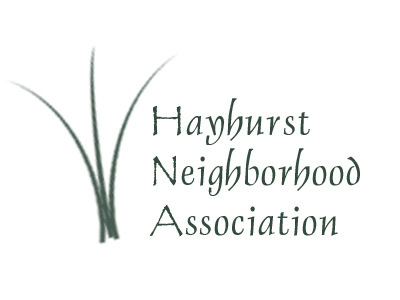Hayhurst
Our Information
- Contact List
- Our contact information...
- Newsletter Archive
- Post Your Newsletter
About Us
Hayhurst
Hayhurst Neighborhood History
The first group of people to settle in the Hayhurst neighborhood were pioneers from the mid-west. They settled here in the mid-1800’s when the area was heavily forested and wild. The area had no roads and no good way to communicate with Portland. The settlers regularly saw deer and bear and had frequent contact with Native Americans. At this time Hayhurst was part of the larger community of Hillsdale.
In the early 1880’s, the Southern Pacific Railroad initiated its line to Hillsboro with track laid through the Hayhurst area. This opened the area for a second group of settlers, European immigrants from Germany and Switzerland. These early settlers were woodsmen, farmers and dairymen. They clear cut most of the timber for these activities. John Hoffman was an early dairyman who built a home at 53rd and Vermont Street, where it still stands. The road from Portland ended at Hillsdale. It was quite difficult to haul Mr. Hoffman’s milk up the hill to Hillsdale, so with the help of Chinese laborers, Mr. Hoffman built a road made from planks. The road was named Hoffman Road and is now called Vermont Street. Many of the Swiss immigrants worked at the Hoffman dairy and then struck out on their own to form their own dairies. Into the early 1990’s, a total of 17 dairies were situated along Hoffman Road. In 1891, Florian Cadonau began a dairy at 35th and Vermont. This was the beginning of Alpenrose Dairy. Alpenrose is an integral part of the community today.
In 1907, the Oregon Electric Railway began service to the area and this brought the beginning of “suburbanization.” This decreased the number of independent farmers, since people could now commute to town and work for wages. Developers began subdividing land along the rail line into “garden home” lots, just big enough for a home and a small garden. When the automobile arrived in the early 1900’s it fostered further suburbanization, new and better roads and less of a dependency on train service. The Oregon Electric Railway ceased passenger operations in 1932. Portland General Electric began service to the area in 1915. In 1920, the state highway department loaned money to Multnomah County to pave the road to the Washington County line, what we now call Beaverton-Hillsdale Highway.
While some of the early housing remains, much of the housing in the Hayhurst neighborhood is tract housing from the 1950’s. Vermont Hills, a highly typical suburban community developed after World War ll, was annexed to the city in 1950. The neighborhood received its name from the elementary school located on S.W. 50th and Iowa Street. Hayhurst Elementary School opened in the early 1950’s, to accommodate the ever-increasing population. The school was originally named David Douglas, but was re-named to Elizabeth Hayhurst Elementary School, after the first president of the Oregon Parent-Teacher Association.
Hayhurst continues to be a low-key, quiet neighborhood. It has changed with the times but still holds on to its rural flavor. It has preserved many old trees, green spaces, and sensitive environmental areas. Many of the families have lived in the neighborhood for more than 20 years and can trace their ancestry to early pioneers in the area. The 2000 census lists Hayhurst’s population at 5,185.
Source
(Thanks to John Dunn at Realty Trust for allowing us to reprint his research on the Hayhurst Neighborhood!)
About our association

Hayhurst Neighborhood Association
The Hayhurst Neighborhood Association (HNA) meets the first Tuesday of every month at 7:00 pm. Our meetings are held at the Vermont Hills Methodist Church located at 6053 SW 55th Drive.
The purpose of the HNA is:
1. To enhance the livability of the area by establishing and maintaining an open line of communications and liaison between the neighborhood, government agencies and other neighborhoods.
2. To provide an open process by which all members of the neighborhood may involve themselves in the affairs of the neighborhood.
3. To be organized exclusively for educational, scientific and charitable purposes only.
HNA Board of Directors
By unanimous vote taken on 12 January 2004, the following Board Members were elected:
Lillie Fitzpatrick, Chair
Chris Raydon-Feeney, Vice-Chair
Gary Hoselton, Secretary
Joe Higgins, Parks, Environment & Livability Chair
Carolyn Rundorf, SW Trails Chair
Land Use Chair (Open)
Safety Chair (Open)


